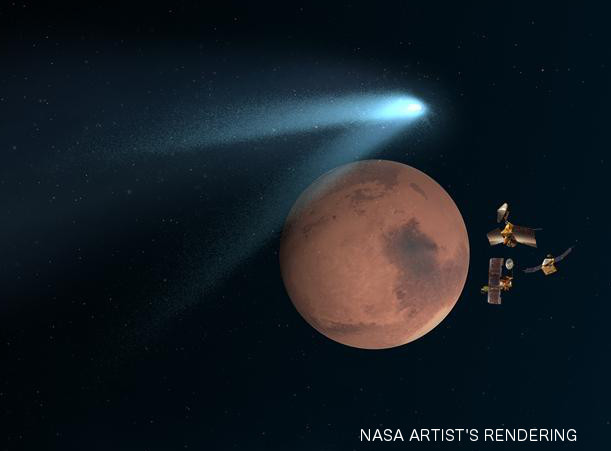THE COMET: FRIEND OR ENEMY?
/ This past Sunday the Comet Siding Spring gave Martians a scare, buzzing the Red Planet at over 200,000 kilometers per hour just over 139,000 kilometers away. OK, maybe buzzing is a bit of an exaggeration, but that distance is ten times closer than any known comet flyby of Earth. The comet’s tail was enough of a concern that NASA and other space agencies arranged to have their Mars orbiters in hiding behind the planet when the dust particles arrived. NASA’s three spacecraft have all got a clean bill of health, and hopefully within days we’ll begin to see some of the information they collected about Siding Spring as it zipped past. The comet came from the Oort Cloud, a vast area of space beyond Neptune and Uranus filled with dust and, well, comets…and very little else.
This past Sunday the Comet Siding Spring gave Martians a scare, buzzing the Red Planet at over 200,000 kilometers per hour just over 139,000 kilometers away. OK, maybe buzzing is a bit of an exaggeration, but that distance is ten times closer than any known comet flyby of Earth. The comet’s tail was enough of a concern that NASA and other space agencies arranged to have their Mars orbiters in hiding behind the planet when the dust particles arrived. NASA’s three spacecraft have all got a clean bill of health, and hopefully within days we’ll begin to see some of the information they collected about Siding Spring as it zipped past. The comet came from the Oort Cloud, a vast area of space beyond Neptune and Uranus filled with dust and, well, comets…and very little else.
This coming November 12th the European Space Agency’s Rosetta spacecraft will make the first ever attempt at a soft landing on a comet (you can even enter a contest to name the landing site). Since arriving near the comet 67P/Churyumov–Gerasimenko on August 6th, Rosetta has been moving closer and will drop its landing component, called Philae, down to the surface. The lander’s instruments will get to work analyzing the comet and keep working until a few months after the comet has made its closest approach to the sun (August 2015) and is heading back out into deep space. If the comet tolerates it for that long. It’s always possible that, while “catching some rays”. the comet could have a serious gas attack and Goodbye Philae.
Apart from both of these events being significant “firsts” in the history of spaceflight, what makes them important over the long term?
There’s a lot of scientific opinion these days that Earth might not be the watery planet we know and love if it weren’t for a heavy bombardment of comets in its early days. It’s even possible that the first components of life arrived via comet express. Paradoxically, comets might also be to blame for some species extinctions over the millions of years before human beings showed up, eventually clearing the path for us to become the top predator on the planet. But what they giveth they can taketh away. A comet strike thirteen thousand years ago may have brought an end to the Clovis people of North America, and a large comet strike now could render homo sapiens extinct, along with most of the species with which we now share the planet.
All of these are good reasons to learn more about comets. Especially the last—if we can really get a good handle on the composition of comets and their life stories, we stand a much better chance of being able to stop a big one headed our way.
There’s another worthwhile reason, though. If we ever do venture beyond the old neighbourhood of the solar system to other stars, our spacecraft will have a heck of a long road to travel with nary a gas station in sight. But they’ll pass through the Oort Cloud which just happens to have lots of these big dusty snowballs with (we think) generous quantities of the hydrogen and oxygen we can use as rocket fuel. Expeditions like Rosetta should confirm this and, if it turns out to be true, we’ll at least know where to look for those vital filling stations in space.
Just watch for the sign that says, “Last gas for 30,000,000,000,000 kilometers!”

